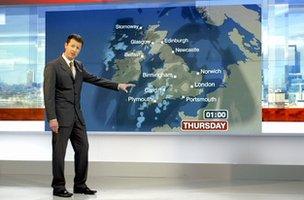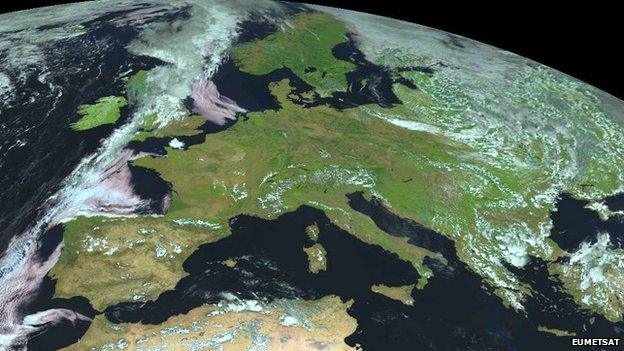Europe's latest weather eye set for launch
- Published
- comments

Meteosat-10, as the spacecraft will become known, is ready for launch this summer
It's hard to overstate the importance of a weather forecast.
To most of us, most of the time, it's just a bit of information that influences which piece of clothing we grab as we leave the house. But every day, all over the world, weather forecasts will also be driving much more significant decision-making.
Some of these decisions will have a lot of money attached to them, like altering the routes of container ships and airliners to take advantage of favourable winds; or changing the volumes of certain produce despatched to supermarket stores because consumer purchases are influenced by temperature.
And then there will be what are literally life or death decisions, such as choosing not to take a particular journey because there's a violent storm coming.
All depend on solid meteorological data and the skill of the people who interpret it to provide our forecasts.
In Europe, this is a really big year for our weather agencies because they get two new satellites that will be absolutely crucial to their work.
One is another polar-orbiting spacecraft called Metop-B, due for launch in May (see previous posting). The other is the latest model in the long-running Meteosat series, which will sit in a "stationary" position 36,000km (22,400 miles) above the equator.
The Meteosats have been providing data since the late 1970s and we are now on the "second generation" (MSG) of spacecraft, external that were introduced in 2002, external to substantially increase the flow and quality of information coming from orbit.
Meteosat-10, as it will be known, should launch in June. It will take pictures of developing weather systems and beam its data back to Earth for immediate analysis and input into numerical weather models.
When the TV presenter shows you the clouds sweeping across the country at the end of the evening news - that'll be Meteosat.

Forecasts incorporate a range of data drawn from satellites, balloons, radar and fixed stations
The information is acquired at huge expense. In fact, these satellite programmes are so costly that European nations have clubbed together in an organisation called Eumetsat, external to share the burden. The latest Meteosat series, for example, is priced at some 2.2bn euros (£1.75bn).
The natural desire for fiscal efficiency demanded that the four spacecraft built for the programme were all made at the same time (it's cheaper to mass produce), even though their launch would have to be staggered to provide continuity of operation over 20 years. (Each satellite has a design life in orbit of seven years, so four overlapping platforms give you two decades' service.)
Of course, the consequence of this approach means you end up having a lot of very valuable, high-precision engineering sitting in store. Meteosat-10, the third platform to fly, has spent eight years on the ground waiting to make its ascent to orbit.
Meteosat-11, the last of the second-generation spacecraft, won't get to the launchpad for another three years at least.
The spacecraft haven't exactly gathered dust because they've been kept in an environmentally controlled cleanroom, but it's been an interesting situation for engineers to see some of their best endeavours sit in a corner for a decade and do nothing.
Alain Ratier: 'MSG is still a state of the art system'
When Meteosat-10 was pulled out of store, it was given a thorough check-over. The concern might be that some components or sub-systems had degraded over time. As it turns out, very little has required attention.
"We have observed some minor degradation in some materials, such as the Velcro used to attach insulation," says Jean-Jacques Juillet from manufacturer Thales Alenia Space, external in Cannes, France.
"This has been understood and we have exchanged the parts. For the rest, no significant problem has been encountered and we are ready for launch as expected."

Meteosats are now sending down detailed images of Europe every five minutes
There is, however, another, and perhaps more pressing, concern that follows from the build-and-store approach - and that relates to technological obsolescence.
Jean-Jacques Juillet: 'The satellites are made in batches'
The present Meteosats were designed in the 1990s; their hardware is a world away from what you could conceivably put into a weather spacecraft today.
So it's paramount you squeeze as much performance as possible out of the existing equipment.
There are two ways of doing this. The first is to use the Meteosats in novel ways.
Originally, it was envisaged that as each spacecraft was launched, it would take over observing duties from its predecessor, which would then become the on-standby reserve. But Eumetsat found that it could substantially add value to the type of data acquired if the back-up was used in a different observing mode.
Today, one Meteosat builds images of the entire field of view - a full Earth disc - in 15 minutes, while the second spacecraft rapidly scans a smaller area covering Europe, to provide more detailed imagery in just five minutes.
This allows the weather agencies to better follow the development of powerful and potentially dangerous thunderstorms.
The other way to push the system is to make the data work harder.
"To do this, we need to innovate on the ground, to infuse science into the processing to extract more information from the observations, which remain the same across the generation of satellites. So, you learn new ways to use the data," explains Alain Ratier, the director-general of Eumetsat.
"We are now better able to forecast intense storms from water vapour images. Another example is volcanic ash - MSG was not produced to detect ash but the scientists are now developing new algorithms to extract concentration in the atmosphere which is key for aviation.
"Another example is mapping fog, which is done by integrating Meteosat data with information from other sources. And this of course is very important for transport.
"We need to be innovative, but we also need to be cost-efficient which relates to the way we procure satellites. We cannot have Olympic-type investment cycles because it would result in a much bigger financial burden on our member states.
"But I can say confidently that Meteosat-10 will be the most capable imaging mission in geostationary orbit today."
Obviously, there comes a point where old systems cannot be stretched any further and you simply have to move to newer technology.
That's why a third generation of Meteosats has just been ordered. This will cost 3.4bn euros to guarantee space-borne meteorological data until 2040. The first of these satellite is likely to fly in 2018.
- Published25 February 2011